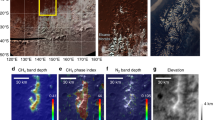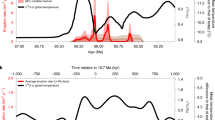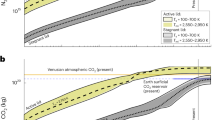Abstract
Pluto has a variety of surface frosts and landforms as well as a complex atmosphere1. There is ongoing geological activity related to the massive Sputnik Planitia glacier, mostly made of nitrogen (N2) ice mixed with solid carbon monoxide and methane2, covering the 4-kilometre-deep, 1,000-kilometre-wide basin of Sputnik Planitia1,3 near the anti-Charon point. The glacier has been suggested to arise from a source region connected to the deep interior, or from a sink collecting the volatiles released planetwide1. Thin deposits of N2 frost, however, were also detected at mid-northern latitudes and methane ice was observed to cover most of Pluto except for the darker, frost-free equatorial regions2. Here we report numerical simulations of the evolution of N2, methane and carbon monoxide on Pluto over thousands of years. The model predicts N2 ice accumulation in the deepest low-latitude basin and the threefold increase in atmospheric pressure that has been observed to occur since 19884,5,6. This points to atmospheric–topographic processes as the origin of Sputnik Planitia’s N2 glacier. The same simulations also reproduce the observed quantities of volatiles in the atmosphere and show frosts of methane, and sometimes N2, that seasonally cover the mid- and high latitudes, explaining the bright northern polar cap reported in the 1990s7,8 and the observed ice distribution in 20152. The model also predicts that most of these seasonal frosts should disappear in the next decade.
This is a preview of subscription content, access via your institution
Access options
Subscribe to this journal
Receive 51 print issues and online access
$199.00 per year
only $3.90 per issue
Buy this article
- Purchase on Springer Link
- Instant access to full article PDF
Prices may be subject to local taxes which are calculated during checkout


Similar content being viewed by others
Change history
30 November 2016
‘Sputnik Planum’ was replaced with ‘Sputnik Planitia’ throughout, and ref. 13 was updated.
References
Stern, A. S. et al. The Pluto system: initial results from its exploration by New Horizons. Science 350, aad1815 (2015)
Grundy, W. M. et al. Surface compositions across Pluto and Charon. Science 351, aad9189 (2016)
Moore, J. F. et al. The geology of Pluto and Charon through the eyes of New Horizons. Science 351, 1284–1293 (2016)
Elliot, J. L. et al. Changes in Pluto’s atmosphere: 1988–2006. Astrophys. J. 134, 1–13 (2007)
Olkin, C. B. et al. Evidence that Pluto’s atmosphere does not collapse from occultations including the 2013 May 04 event. Icarus 246, 220–225 (2015)
Sicardy, B. et al. Pluto’s atmosphere from the 29 June 2015 ground-based stellar occultation at the time of the New Horizons flyby. Astrophys. J. Lett. 819, L38 (2016)
Buie, M. W., Tholen, D. J. & Horne, K. Albedo maps of Pluto and Charon—initial mutual event results. Icarus 97, 211–227 (1992)
Stern, S. A., Buie, M. W. & Trafton, L. M. HST high-resolution images and maps of Pluto. Astron. J. 113, 827–843 (1997)
Forget, F., Bertrand, T., Vangvichith, M. & Leconte, A. 3D global climate model of the Pluto atmosphere to interpret New Horizons observations, including the N2, CH4 and CO cycles and the formation of organic hazes. Abstract DPS 47, 105.12, http://adsabs.harvard.edu/abs/2015DPS....4710512F (2015)
Lellouch, E., Stansberry, J., Emery, J., Grundy, W. & Cruikshank, D. Thermal properties of Pluto’s and Charon’s surfaces from Spitzer observations. Icarus 214, 701–716 (2011)
Hansen, C. J. & Paige, D. A. Seasonal nitrogen cycles on Pluto. Icarus 120, 247–265 (1996)
Young, L. A. Pluto’s seasons: new predictions for New Horizons. Astrophys. J. 766, L22 (2013)
Hamilton, D. P. et al. The rapid formation of Sputnik Planitia early in Pluto's history. Nature http://dx.doi.org/10.1038/nature20586 (2016)
James, P. B., Kieffer, H. H. & Paige, D. A. in Mars (eds Kieffer, H., Jakosky, B., Snyder C. & Matthews, M. ) 934–968 (Univ. Arizona Press, 1992)
Gladstone, G. R. et al. The atmosphere of Pluto as observed by New Horizons. Science 351, aad8866 (2016)
Merlin, F. New constraints on the surface of Pluto. Astron. Astrophys. 582, A39 (2015)
Lellouch, E., de Bergh, C., Sicardy, B., Kaufl, H. U. & Smette, A. High resolution spectroscopy of Pluto’s atmosphere: detection of the 2.3 μm CH4 bands and evidence for carbon monoxide. Astron. Astrophys. 530, L4 (2011)
Buie, M. W., Grundy, W. M., Young, E. F., Young, L. A. & Stern, S. A. Pluto and Charon with the Hubble Space Telescope. II. Resolving changes on Pluto’s surface and a map for Charon. Astron. J. 139, 1128–1143 (2010)
Lellouch, E. et al. Exploring the spatial, temporal, and vertical distribution of methane in Pluto’s atmosphere. Icarus 246, 268–278 (2015)
Earle, A. M. & Binzel, R. P. Pluto’s insolation history: latitudinal variations and effects on atmospheric pressure. Icarus 250, 405–412 (2015)
Stansberry, J. A. et al. A model for the overabundance of methane in the atmospheres of Pluto and Triton. Planet. Space Sci. 44, 1051–1063 (1996)
Fray, N. & Schmitt, B. Sublimation of ices of astrophysical interest: a bibliographic review. Planet. Space Sci. 57, 2053–2080 (2009)
Forget, F. et al. A post-New Horizons global climate model of Pluto including the N2, CH4 and CO cycles. Icarus (submitted)
Acknowledgements
We thank the New Horizons team for this successful mission. We also thank E. Lellouch, E. Millour and M. J. Wolff for comments on the manuscript. We are grateful to M. Vangvichith for her contribution to an early version of the model, and to the Institut de Formation Doctorale for supporting this work.
Author information
Authors and Affiliations
Contributions
F.F. and T.B. designed and developed the model. T.B. performed the simulations. Both authors contributed to the writing of the manuscript.
Corresponding author
Ethics declarations
Competing interests
The authors declare no competing financial interests.
Extended data figures and tables
Extended Data Figure 1 Mars in mid-southern spring.
This composite image shows the 7-km-deep, 2,000-km-wide deep Hellas Planitia impact basin covered by seasonal CO2 ice. The physical processes that favour the condensation of the CO2 atmosphere at the bottom of the Hellas basin is the same as for Pluto’s N2 atmosphere in Sputnik Planitia. In both basins, surface pressures are larger than in the surrounding regions and condensation temperatures Tc are higher. This corresponds to a stronger thermal infrared cooling (proportional to Tc4), which is balanced by a proportionally more intense condensation rate (latent heat). Images obtained by the Mars Global Surveyor Mars Orbiter Camera in November 2006, at solar longitude (the Mars–Sun angle, measured from the Northern Hemisphere spring equinox where Ls = 0°) Ls = 137° (image credit NASA/JPL/MSSS; http://photojournal.jpl.nasa.gov/catalog/PIA01888).
Extended Data Figure 2 Evolution of surface pressure during the first 15,000 Earth years of the reference simulation (same as Fig. 1).
At least 10,000 Earth years are necessary to equilibrate the N2 ice in the basin and obtain a year-to-year repetitive pattern of surface pressure.
Extended Data Figure 3 Latitudinal distribution of CH4 ice over three Pluto years in our reference simulation, as in Figs 1 and 2.
The colour scale measures methane ice on the surface, in kilograms per square metre. The time axis starts at the solar longitude Ls = 0°. In addition to the permanent methane ice reservoir in the Sputnik Planitia basin, the methane cycle exhibits seasonal polar frosts of methane. The southern polar frosts remain in place longer than the northern frost, owing to the longer duration of the southern winter season. At mid-northern latitudes, the Sputnik Planitia basin is a permanent reservoir of CH4 ice. CH4 frost preferentially accumulates at the poles during autumn and winter, but better resists sublimation at low latitudes during late spring, especially in the southern hemisphere.
Source data
Rights and permissions
About this article
Cite this article
Bertrand, T., Forget, F. Observed glacier and volatile distribution on Pluto from atmosphere–topography processes. Nature 540, 86–89 (2016). https://doi.org/10.1038/nature19337
Received:
Accepted:
Published:
Issue Date:
DOI: https://doi.org/10.1038/nature19337
This article is cited by
-
Large-scale cryovolcanic resurfacing on Pluto
Nature Communications (2022)
-
Sublimation as an effective mechanism for flattened lobes of (486958) Arrokoth
Nature Astronomy (2020)
-
Equatorial mountains on Pluto are covered by methane frosts resulting from a unique atmospheric process
Nature Communications (2020)
-
Nitrogen Atmospheres of the Icy Bodies in the Solar System
Space Science Reviews (2020)
-
Washboard and fluted terrains on Pluto as evidence for ancient glaciation
Nature Astronomy (2018)
Comments
By submitting a comment you agree to abide by our Terms and Community Guidelines. If you find something abusive or that does not comply with our terms or guidelines please flag it as inappropriate.




